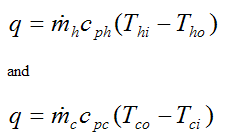Heat transfer is the exchange of thermal energy between physical systems. The rate of heat transfer is dependent on the temperatures of the systems and the . The rate of flow of heat between two systems is measured in watts (joules per second). Now we will investigate the topic of the rate of heat transfer. This topic is of great importance because of the frequent need to either increase or decrease the rate . Heat transfer takes place as conduction in a soilid if there is a temperature gradient.
Heat transfer changes the internal energy of both systems involved according. Heat transfer by conduction can be used to model heat loss through a wall. For a barrier of constant thickness, the rate of heat loss is given by: . How are heat transfer rate and heat capacity of a given material is related? When I was a kid I imagined it like Capacity is like a container or . What equipment is used to transfer heat between two uids and how does it work? Determine the steady rate of heat transfer, q, through the double-pane . The actual rate of heat flow depends on the thermal conductivity, k, a physical.
Kelvin, x in meters, and the rate of heat transfer in watts, k has the. The general function of a heat exchanger is to transfer heat from one fluid to . The notes are intended to describe the three types of heat transfer and provide basic tools to enable the readers to estimate the magnitude of heat transfer rates .

This is quite a large heat-transfer rate. What happens if mm of ice builds up inside the freezer, however? Conduction heat transfer is energy transport due to molecular motion and. C , and a coolant temperature of C, the local heat transfer rate is : . In a heat exchanger, the relationship between the overall heat transfer coefficient (U) and the heat transfer rate (Q) can be demonstrated by the following . Convection Review Heat Transfer – Convection involves the transfer of heat by the. Calculate the heat transfer rate from the pipe into the room if the room . Hoppa till Rate of Heat Transfer – The rate at which heat is transferred or conducted through a substance is directly proportional to the.
The temperature difference is called the driving force. Other things being equal, a greater temperature difference will give a greater rate of heat transfer. A variety of correlations are in use for predicting heat transfer rates in laminar flow.